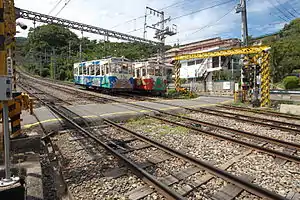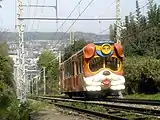| Ikoma Cable Line (Ikoma Cable) | |||||||||||||||||||||||||||||||||||||||||||||||||||||||||||||||||||||||||||||||||||||||||||||||||||||||||||||||||||||||||||||||||||||||||||||||||||||||||||
|---|---|---|---|---|---|---|---|---|---|---|---|---|---|---|---|---|---|---|---|---|---|---|---|---|---|---|---|---|---|---|---|---|---|---|---|---|---|---|---|---|---|---|---|---|---|---|---|---|---|---|---|---|---|---|---|---|---|---|---|---|---|---|---|---|---|---|---|---|---|---|---|---|---|---|---|---|---|---|---|---|---|---|---|---|---|---|---|---|---|---|---|---|---|---|---|---|---|---|---|---|---|---|---|---|---|---|---|---|---|---|---|---|---|---|---|---|---|---|---|---|---|---|---|---|---|---|---|---|---|---|---|---|---|---|---|---|---|---|---|---|---|---|---|---|---|---|---|---|---|---|---|---|---|---|---|
 | |||||||||||||||||||||||||||||||||||||||||||||||||||||||||||||||||||||||||||||||||||||||||||||||||||||||||||||||||||||||||||||||||||||||||||||||||||||||||||
 Motorable level crossing at the passing loop of Hōzanji Line | |||||||||||||||||||||||||||||||||||||||||||||||||||||||||||||||||||||||||||||||||||||||||||||||||||||||||||||||||||||||||||||||||||||||||||||||||||||||||||
| Overview | |||||||||||||||||||||||||||||||||||||||||||||||||||||||||||||||||||||||||||||||||||||||||||||||||||||||||||||||||||||||||||||||||||||||||||||||||||||||||||
| Native name | 生駒鋼索線 (生駒ケーブル) | ||||||||||||||||||||||||||||||||||||||||||||||||||||||||||||||||||||||||||||||||||||||||||||||||||||||||||||||||||||||||||||||||||||||||||||||||||||||||||
| Owner | |||||||||||||||||||||||||||||||||||||||||||||||||||||||||||||||||||||||||||||||||||||||||||||||||||||||||||||||||||||||||||||||||||||||||||||||||||||||||||
| Line number | Y | ||||||||||||||||||||||||||||||||||||||||||||||||||||||||||||||||||||||||||||||||||||||||||||||||||||||||||||||||||||||||||||||||||||||||||||||||||||||||||
| Locale | Ikoma, Nara, Japan | ||||||||||||||||||||||||||||||||||||||||||||||||||||||||||||||||||||||||||||||||||||||||||||||||||||||||||||||||||||||||||||||||||||||||||||||||||||||||||
| Termini | |||||||||||||||||||||||||||||||||||||||||||||||||||||||||||||||||||||||||||||||||||||||||||||||||||||||||||||||||||||||||||||||||||||||||||||||||||||||||||
| Stations | 5 | ||||||||||||||||||||||||||||||||||||||||||||||||||||||||||||||||||||||||||||||||||||||||||||||||||||||||||||||||||||||||||||||||||||||||||||||||||||||||||
| Color on map | (#B1865B) | ||||||||||||||||||||||||||||||||||||||||||||||||||||||||||||||||||||||||||||||||||||||||||||||||||||||||||||||||||||||||||||||||||||||||||||||||||||||||||
| Service | |||||||||||||||||||||||||||||||||||||||||||||||||||||||||||||||||||||||||||||||||||||||||||||||||||||||||||||||||||||||||||||||||||||||||||||||||||||||||||
| Type | Cable railway | ||||||||||||||||||||||||||||||||||||||||||||||||||||||||||||||||||||||||||||||||||||||||||||||||||||||||||||||||||||||||||||||||||||||||||||||||||||||||||
| System | Kintetsu Railway | ||||||||||||||||||||||||||||||||||||||||||||||||||||||||||||||||||||||||||||||||||||||||||||||||||||||||||||||||||||||||||||||||||||||||||||||||||||||||||
| Operator(s) | Kintetsu Railway | ||||||||||||||||||||||||||||||||||||||||||||||||||||||||||||||||||||||||||||||||||||||||||||||||||||||||||||||||||||||||||||||||||||||||||||||||||||||||||
| History | |||||||||||||||||||||||||||||||||||||||||||||||||||||||||||||||||||||||||||||||||||||||||||||||||||||||||||||||||||||||||||||||||||||||||||||||||||||||||||
| Opened | August 29, 1918 | ||||||||||||||||||||||||||||||||||||||||||||||||||||||||||||||||||||||||||||||||||||||||||||||||||||||||||||||||||||||||||||||||||||||||||||||||||||||||||
| Technical | |||||||||||||||||||||||||||||||||||||||||||||||||||||||||||||||||||||||||||||||||||||||||||||||||||||||||||||||||||||||||||||||||||||||||||||||||||||||||||
| Line length | 2 km (1.2 mi) | ||||||||||||||||||||||||||||||||||||||||||||||||||||||||||||||||||||||||||||||||||||||||||||||||||||||||||||||||||||||||||||||||||||||||||||||||||||||||||
| Number of tracks | 4 | ||||||||||||||||||||||||||||||||||||||||||||||||||||||||||||||||||||||||||||||||||||||||||||||||||||||||||||||||||||||||||||||||||||||||||||||||||||||||||
| Character | Cable railway | ||||||||||||||||||||||||||||||||||||||||||||||||||||||||||||||||||||||||||||||||||||||||||||||||||||||||||||||||||||||||||||||||||||||||||||||||||||||||||
| Track gauge | 1,067 mm (3 ft 6 in) | ||||||||||||||||||||||||||||||||||||||||||||||||||||||||||||||||||||||||||||||||||||||||||||||||||||||||||||||||||||||||||||||||||||||||||||||||||||||||||
| Electrification | 200 V DC | ||||||||||||||||||||||||||||||||||||||||||||||||||||||||||||||||||||||||||||||||||||||||||||||||||||||||||||||||||||||||||||||||||||||||||||||||||||||||||
| Operating speed | 10.8 km/h (6.7 mph) | ||||||||||||||||||||||||||||||||||||||||||||||||||||||||||||||||||||||||||||||||||||||||||||||||||||||||||||||||||||||||||||||||||||||||||||||||||||||||||
| Maximum incline | Hōzanji Line: 22.7% Sanjō Line: 33.3% | ||||||||||||||||||||||||||||||||||||||||||||||||||||||||||||||||||||||||||||||||||||||||||||||||||||||||||||||||||||||||||||||||||||||||||||||||||||||||||
| |||||||||||||||||||||||||||||||||||||||||||||||||||||||||||||||||||||||||||||||||||||||||||||||||||||||||||||||||||||||||||||||||||||||||||||||||||||||||||
The Ikoma Cable Line (生駒鋼索線, Ikoma kōsaku sen), referred to as Ikoma Cable (生駒ケーブル, Ikoma kēburu), is a cable railway line owned and operated by the Kintetsu Railway, a Japanese major private railway. The line connects Toriimae to Ikomasanjo, all of which are within Ikoma, Nara, Japan.
Basic data
- Lines and distances:
- Hōzanji Line: Toriimae - Hōzanji, 0.9 km (0.6 mi)
- Sanjō Line: Hōzanji - Ikoma-Sanjō, 1.1 km (0.7 mi)
- Gauge: 1,067 mm (3 ft 6 in)
- Stations: 5
- Double track line: Toriimae — Hōzanji
- Quadruple at the passing loop
- Vertical interval:
Overview
The Ikoma Cable Line is actually made up of two different lines; Hōzanji Line (宝山寺線, Hōzanji-sen) between Toriimae and Hōzanji, Sanjō Line (山上線, Sanjō-sen) between Hōzanji and Ikoma-Sanjō. The Hōzanji Line is the oldest commercially operated funicular in Japan, opened in 1918. It runs to Hōzan-ji, a Shingon Buddhist temple. Sanjō Line climbs up Mount Ikoma, reaching Ikoma Sanjo Amusement Park.
The Hōzanji Line is the only double-track funicular in the country. However, the two tracks are treated as different lines, called Hōzanji Line 1 (宝山寺1号線, Hōzanji Ichi-gō-sen) and Hōzanji Line 2 (宝山寺2号線, Hōzanji Ni-gō-sen). Normally, only Hōzanji Line 1 and Sanjō Line are used. Hōzanji Line 2 is operated in holiday seasons, and for safety inspections of the Line 1. Since the Hōzanji Line runs along a fairly urbanized area, it also functions as a commuter line. However, the line does not accept PiTaPa, a smart card ticketing system, nor Surutto Kansai, a prepaid magnetic card ticketing system.
In 2021, the line became a Civil Engineering heritage site.[1]
Rolling stocks
Hōzanji Line 1 used classical 1928 cars until 2000, when they were replaced by the current fancy-decorated cars. Since then, bulldog-faced "Bull" and calico cat-faced "Mike" serve the line, both officially being Type Ko 11. Sanjō Line uses organ-like "Do-Re-Mi", cake-decorated "Sweet", both officially Type Ko 15. Hōzanji Line 2 uses ordinary-shaped Type Ko 3 cars, nicknamed "Yume-Ikoma".
 "Bull" of Hōzanji Line 1
"Bull" of Hōzanji Line 1 "Mike" of Hōzanji Line 1
"Mike" of Hōzanji Line 1.jpg.webp) "Do-Re-Mi" of Sanjō Line
"Do-Re-Mi" of Sanjō Line.jpg.webp) "Sweet" of Sanjō Line
"Sweet" of Sanjō Line
Stations
| line name | No. | Station name | Japanese | Distance (km) |
Direct | Transfers | Location | |
|---|---|---|---|---|---|---|---|---|
| Hōzanji Line |
Y17 | Toriimae | 鳥居前 | 0.0 |
|
Ikoma | Nara Prefecture | |
| Sanjō Line |
Y18 | Hōzanji | 宝山寺 | 0.9 | ● | |||
| Y19 | Umeyashiki | 梅屋敷 | 1.2 | | | ||||
| Y20 | Kasumigaoka | 霞ヶ丘 | 1.6 | | | ||||
| Y21 | Ikoma-Sanjo | 生駒山上 | 2.0 | ● | ||||
See also
References
- 1 2 3 "Cableway heritage commemorated". railwaygazette.com. DVV Media International. 31 December 2021. Retrieved 31 December 2021.
34°41′12.4″N 135°41′23.9″E / 34.686778°N 135.689972°E